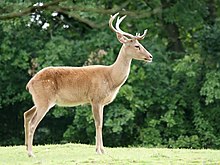Eld's Deer
| Eld's deer | |
|---|---|
 |
|
| Burmese brow-antlered deer at Chester Zoo | |
| Scientific classification | |
| Kingdom: | Animalia |
| Phylum: | Chordata |
| Class: | Mammalia |
| Order: | Artiodactyla |
| Family: | Cervidae |
| Subfamily: | Cervinae |
| Genus: | Panolia |
| Species: | P. eldii |
| Binomial name | |
|
Panolia eldii (M'Clelland, 1842) |
|
| Synonyms | |
|
|
Eld's deer (Panolia eldii), also known as the thamin or brow-antlered deer, is an endangered species of deer indigenous to Southeast Asia. The species was first discovered by Westerners in Manipur in India in 1839. The original scientific name, Cervus eldi, was coined in 1844 in honour of Lt. Percy Eld, a British officer. The three subspecies of the Eld's deer are:
The following measurements have been reported for the Eld's deer:
The deer are generally of medium size and are similar to the size and shape of the barasingha. The species has a very regal and graceful Cervus physique. Its legs are thin and long, and has a long body with a large head on a thin neck. The throat of a male has a thick mane of long hair. Males (stags) are taller and heavier than the females (hinds or does). Their coats, rough and coarse, change colour with the season; in summer the colour is reddish-brown, while in winter, it turns dark brown, with males tending to be darker than the females. The tail is short in length and the rump has no distinct patch. Despite these features, they are actually related to the Père David's deer. The antlers, bow- or lyre-shaped, do not grow upwards, but tend to grow outwards and then inwards; a smaller branch grows towards the front of the head. The brow tines are especially long and noticeable. The brow-antlered deer is so named because they have long brow tines. They shed their antlers every year, with the largest size attained during the breeding season.
The conservation status of three subspecies of Eld's deer, by country, are:
The Keibul Lamjao National Park (KLNP), covering an area of 40 km2 (15.4 sq mi) of marshland called the Phumdis within the larger Loktak Lake, was gazetted in 1977 specifically to protect the Cervus eldi eldi, the sangai in Meitei. Over time, public awareness and local support have evolved for conserving the subspecies of the endemic endangered Elds' deer. Concerted actions have been initiated to stop encroachment of the park and adequate security arrangements have been made to stop poaching. This fact is very somberly presented in a story form in a popular children's magazine called Chandamama, which gives a first-person symbolic narrative by the affected 'deer' itself. The final conclusion by the deer, quoted below, concisely puts the security provided in the park in a proper perspective.
...
Wikipedia

